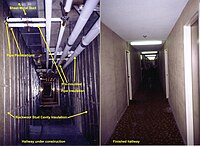
Photo from wikipedia
Abstract The impact of shading on the energy demand of buildings belonging to the urban context cannot be ignored, which will cause inaccuracies in the prediction of building loads. The… Click to show full abstract
Abstract The impact of shading on the energy demand of buildings belonging to the urban context cannot be ignored, which will cause inaccuracies in the prediction of building loads. The purpose of this study is to predict the impact of shading on building energy from nearby buildings by using a parametric method, which involved 93114 number of simulations. The building morphology and blocks constitute the simulation cases and are simulated considering seven cities in four thermal climate zones. The climate characteristic parameters and geographic location information of the cities are used as the input for the simulation to obtain a regression model that can be applied in most areas of China to predict the shading effect. Grasshopper and EnergyPlus were used to develop the physical models and estimate the building loads for stand-alone buildings or buildings in a network. The results demonstrate that the influence of shading varies significantly under different scenarios, and cooling loads can be over-estimated up to 45% and heating load under-estimated up to 21% in some cities such as Lanzhou. Using the distribution range of 95% relative errors to evaluate the reliability and generalization of the model, the results show that the established support vector regression can effectively calculate the shading effect. The proposed method can quickly estimate the building energy demand by considering the shading effect, which is expected to provide technical support for urban design and energy planning.
Journal Title: Building and Environment
Year Published: 2021
Link to full text (if available)
Share on Social Media: Sign Up to like & get
recommendations!